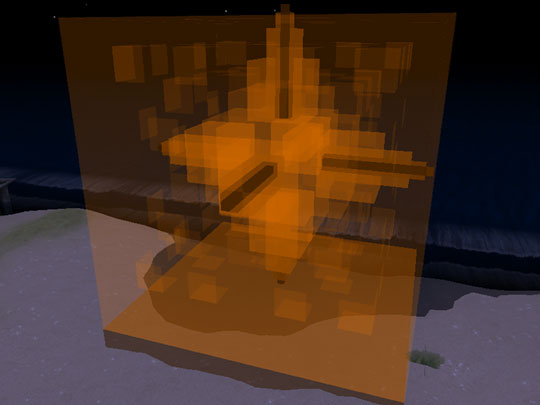Anahata, The Mute Swan (2006)

Anahata, The Mute Swan was an immersive audiovisual sculpture for Second Life by Adam Nash in 2006.
DESCRIPTION
"Look, how the floor of heavenIs thick inlaid with patines of birght gold:
There's not the smallest orb which thou behold'st
But in his motion like an angel sings....
Such harmony is in immortal souls;
But whilst this muddy vesture of decay
Doth grossly close it in, we cannot hear it."
-- Shakespeare, The Merchant of Venice (V,i)
According to the Sangita Makaranda (I 4-6), there are two kinds of sound, anahata (unstruck) and ahata (struck). Anahata is a vibration of the ether and is not perceived by the physical sense, since it is not the result of physical shock, as all other sounds are. The Sangita Makaranda says of anahata, "in this unstruck sound the Gods delight. The Yogis, the Great Spirits, projecting their minds by an effort of the mind into this unstruck sound, depart, attaining Liberation".
This is very similar to the ancient Greek idea of the Music of the Spheres. Pythagoras believed that harmonic ratios and planetary motion were both expressions of a universal law governing music and mathematics. Pythagoras could supposedly hear the celestial music that this law implies.
All the sounds we hear are imperfect. For a sound to be perfect, it would have to have started before we were born and continue unabated through our life and after our death. But, according to R. Murray Schafer, such a sound "would be perceived by us as silence. That is why... all research into sound must conclude with silence. Not the silence of negative vacuum, but the positive silence of perfection and fulfilment."
But what of the virtual world? Is there silence in the virtual world? Is it all silence, with only sound objects (Pierre Schaeffer's objets sonore, "pieces of time torn from the cosmos") placed strategically, recontextualised to support the illusion that the virtual is an illusion of reality? Perhaps the real sound of the virtual environment is the hum, whir and click of the processors doing the calculations responsible for rendering the audiovisual virtua, the breathing of the users and their click clack of mouse and keyboard. Others can't hear it, but imagine how loud it is - 25,000 people all breathing, clicking and clacking at their humming, whirring computers.
Schaeffer's concept of 'reduced listening' ("hearing a sound as sound, rahter than listening for its cause or meaning", as Toop relays Chion's explanation of the concept) is the only kind of listening possible in the virtual world. Sound is prior to context. The sound creates the context. That context may in the service of the illusion, or it may create a context without precedent in the physical world - especially interesting when the sound source is a digital sample of a real world sound, which is the only kind of sound that SL, and most virtual environments, allow.
This work, Anahata The Mute Swan, is an attempt to create an immersive audiovisual sculpture that tries to find silence within noise and acceptance of confusion. The inside is different from the outside. The role of the user is simply to move about within the work, perceiving the same sounds and vision differently according to where they are. Relationships change. The user tries to make sense of it, or not.
The work also superficially references a previous work of mine called Scorched Happiness, a multi-user realtime 3D work from 2004.
REFERENCES
R. Murray Schafer, "The Soundscape - Our Sonic Environment and the Tuning of the World", Vermont: Destiny Books, 1994 (Orignially published "The Tuning of the World", New York: Knopf, 1977)."The Nature of Sound", in the article "Hindu Music", accessed on the web at http://www.hinduwisdom.info/Hindu_Music.htm
David Toop, "Haunted Weather - Music Silence and Memory", London: Serpent's Tail, 2004.